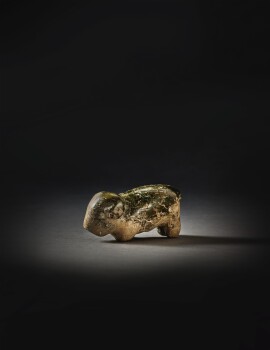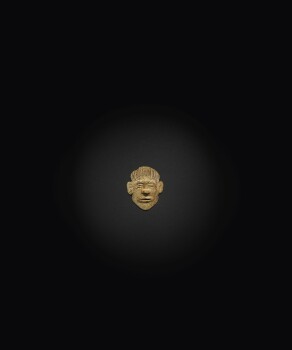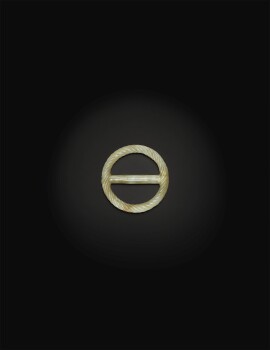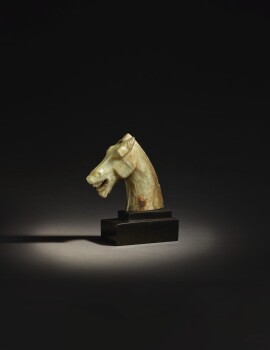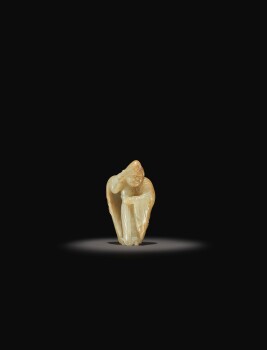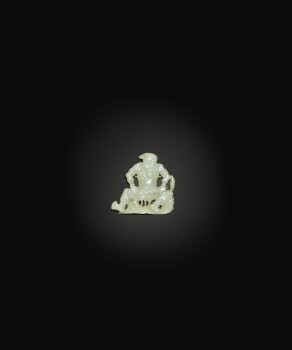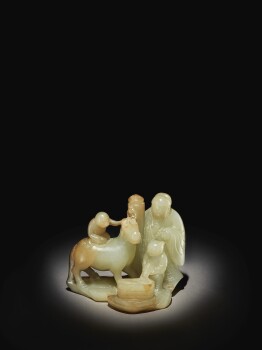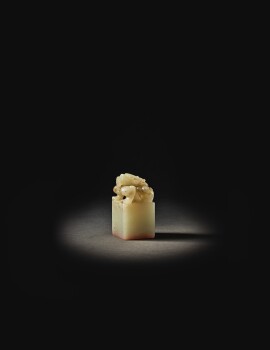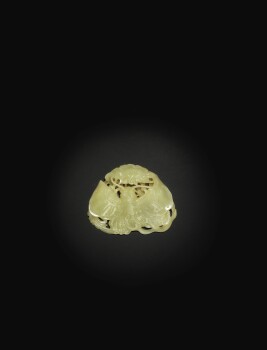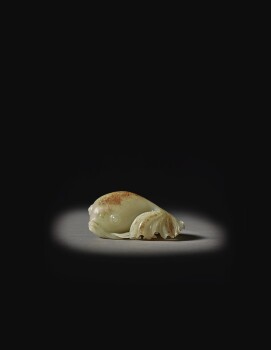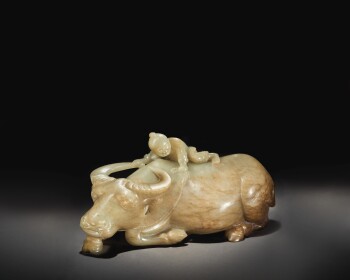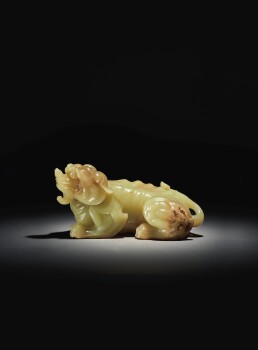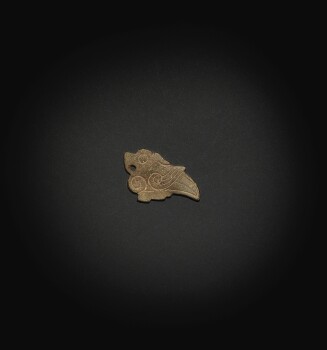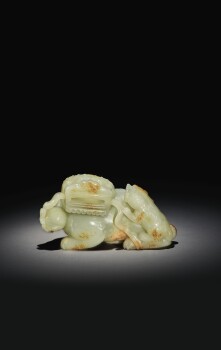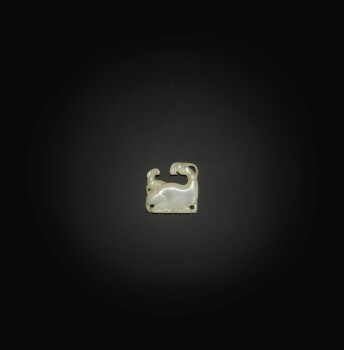M ore than 60 jades from the renowned collection of Stephen Junkunc, III (d. 1978) reflect the development of jade carving in China from the Neolithic period to the Qing dynasty. Highlights include a finely carved Ming dynasty celadon and russet jade ‘boy and buffalo’ group, an exceedingly rare and large Qianlong period yellow and russet jade ‘mythical beast’ and an important white jade seal from the Daoguang period.
Featured Highlights

- Neolithic Period
- Shang Dynasty
- Eastern Zhou Dynasty, Warring States Period
- Han-Six Dynasties
- Tang Dynasty
- Song Dynasty
- Yuan Dynasty
- Ming Dynasty
- Qing Dynasty
-
 Neolithic PeriodA RARE DARK GREEN STONE CARVING OF A RAM
Neolithic PeriodA RARE DARK GREEN STONE CARVING OF A RAM
NEOLITHIC PERIOD
LOT SOLD $37,800
This exceptionally rare naturalistic Neolithic carving is closely related to a green stone sculpture of a ram, now in the collection of the National Museum of Asian Art in Washington D.C, where scholars attribute it to the Shijiahe Culture, circa 2200-2000 B.C. -
 Shang DynastyA RARE JADE 'HUMAN MASK' FITTING
Shang DynastyA RARE JADE 'HUMAN MASK' FITTING
SHANG DYNASTY
LOT SOLD $81,900
Boldly carved with distinctive facial features, the present piece belongs to a small group of Shang human head-form fittings sharing similar characteristics. a related jade fitting rendered with similar features in the Palace Museum, Beijing, and two others, one with incised hair, and the other without, excavated from the Fuhao tomb in Anyang, Henan province, now in the National Museum of China, Beijing. -
 Eastern Zhou Dynasty, Warring States PeriodA VERY RARE CELADON JADE FITTING
Eastern Zhou Dynasty, Warring States PeriodA VERY RARE CELADON JADE FITTING
EASTERN ZHOU DYNASTY, WARRING STATES PERIOD
LOT SOLD $18,900
Jade fittings of this type appear to be extremely rare, although a closely related fitting is recorded in the collection of the National Palace Museum, Taipei, published on the museum’s website. According to the museum, this type of fitting was used to secure belt buckles. -
 Han-Six DynastiesAN EXTREMELY IMPORTANT AND RARE CELADON AND RUSSET JADE HORSE HEAD
Han-Six DynastiesAN EXTREMELY IMPORTANT AND RARE CELADON AND RUSSET JADE HORSE HEAD
HAN - SIX DYNASTIES
LOT SOLD $746,000
Throughout China’s long history, the horse has played a significant role in the expansion and consolidation of the empire. The Han dynasty was repeatedly threatened with attempts by the Xiongnu, the multi-ethnic nomadic group inhabiting the Eurasian Steppe, to raid the northern and eastern boundaries of China’s territories. This led to a search for horses that were superior to China’s own domestic breeds, and better suited to the challenging topographies of the regions. -
 Tang DynastyAN EXCEEDINGLY RARE WHITE AND RUSSET JADE CARVING OF A FOREIGNER
Tang DynastyAN EXCEEDINGLY RARE WHITE AND RUSSET JADE CARVING OF A FOREIGNER
TANG DYNASTY
LOT SOLD $75,600
The Tang dynasty is characterized by its cosmopolitan openness to foreign trade and a rich flourishing of the arts. A mutual exchange of religion, ideas and culture occurred concurrently with the abundant trade along the Silk Road. Within this bustling and welcoming environment, images of foreigners became increasingly popular. Depictions of foreigners during this period can be identified from the broad faces and curly facial hair. -
 Song DynastyA PALE CELADON JADE CARVING OF A RAM
Song DynastyA PALE CELADON JADE CARVING OF A RAM
SONG DYNASTY
ESTIMATE $20,000–30,000
Elegantly worked, this charming ram is indicative of Song dynasty jade carving styles. Two Song dynasty jade deer are carved in a similar fashion, is illustrated in Yang Boda, ed., Zhongguo yuqi quanji [The Complete Compilation of Chinese Jades], vol. 2, Shijiazhuang, 2005, pls 122 & 123; the first with a very similarly shaped face to the present carving, the second with a body like the present. -
 Yuan DynastyAN EXCEEDINGLY RARE WHITE JADE 'GUARDIAN' PLAQUE
Yuan DynastyAN EXCEEDINGLY RARE WHITE JADE 'GUARDIAN' PLAQUE
YUAN DYNASTY
LOT SOLD $107,100
Despite the seated position, this image of a Buddhist guardian exudes vigor and ferociousness from the tension held in the bulging muscles to the strong diagonal contours that enliven the legs, arms, adornments, and hair. The physicality and posture closely resemble the attendant guardians on the monumental stone panels carved with the Four Heavenly Kings under the arched passage of the Cloud Platform at Juyong Pass, Beijing, which was constructed between 1343 and 1345. Only one other jade ‘guardian’ plaque in this style is known, making this an extremely rare example of the type. -

This charming carving is highly unusual in its combination of a monkey on a horse and two figures. While carvings of a monkey and horse, a figure with a horse and a scholar and boy are well known, no other piece that fuses all four elements appear to have been published. The sensitive rendering of each figure in the round, the intricate details, and variety of textures attest to the carver’s skill and ability to capture such a complex scene in jade. Ming DynastyA VERY RARE WHITE AND RUSSET JADE 'SCHOLAR, MONKEY AND HORSE' GROUP
LATE MING DYNASTY
LOT SOLD $100,800
This charming carving is highly unusual in its combination of a monkey on a horse and two figures. While carvings of a monkey and horse, a figure with a horse and a scholar and boy are well known, no other piece that fuses all four elements appear to have been published. The sensitive rendering of each figure in the round, the intricate details, and variety of textures attest to the carver’s skill and ability to capture such a complex scene in jade. -
 Qing DynastyAN IMPORTANT AND RARE IMPERIAL WHITE AND BEIGE JADE 'CHILONG' SEAL
Qing DynastyAN IMPORTANT AND RARE IMPERIAL WHITE AND BEIGE JADE 'CHILONG' SEAL
QING DYNASTY, DAOGUANG PERIOD
ESTIMATE $200,000–300,000
This exquisite seal embodies the special significance of the luxurious Shengde Tang (Hall of Prudent Virtue) to the Daoguang Emperor (r. 1820-1850). The Daoguang Emperor subscribed to the view expressed in the Shangshu that government is virtuous when it serves to nourish the people by improving their livelihood, devoting resources to the common good, and most importantly, promoting ethical thoughts and deeds through cultural education. The present seal, produced between 1831 and 1850, was made for this specific hall, where it was housed and used.

Jade, also known as nephrite, is an extraordinarily hard material requiring specialized tools and techniques in order to be carved. This physical quality has yielded two important cultural consequences for jade’s market and use, starting in the Neolithic period: first, that it has historically been crafted exclusively for an elite audience who could command the labor required to work the stone; and second, that it is extremely durable, possessing the power to withstand time and degradation, and therefore has a strong association with permanence. For these reasons, since antiquity jade articles have been included in elite tombs to accompany the deceased on their eternal passage, and in later periods jade was crafted into the image of deities and related symbols of immortality. The present selection of jades from the Junkunc Collection includes examples of jades crafted with the idea of immortality in mind.

Animals have been a favorite subject for Chinese craftsmen, including jade carvers, from antiquity to the present. Some species were esteemed for the important roles they played in Chinese civilization, such as buffaloes for agriculture and horses for warfare. Yet, others were chosen for their auspicious associations, such as benevolent mythical beasts, or quotidian creatures like butterflies (fudie) and goats (yang) whose names bear a phonetic relationship to the words for ‘fortune and longevity’ and ‘positive energy’, respectively. The present selection of jades from the Junkunc Collection offers a survey of the types of animals that were depicted by Chinese carvers over the millennia and manner in which they were represented in each period.
- Butterfly
- Mythical Beast
- Goldfish
- Water Buffalo
- Mythical Beast
- Birds
- Buddhist Lion
- Goat
- Horse
-
 ButterflyAN EXQUISITELY CARVED YELLOW JADE 'BUTTERFLY'
ButterflyAN EXQUISITELY CARVED YELLOW JADE 'BUTTERFLY'
QING DYNASTY, QIANLONG PERIOD
LOT SOLD $44,100
As an emblem of joy, the butterfly is one of the most popular subjects in Chinese art for its highly auspicious meaning. It represents blessings and richness, as well as happiness and longevity. -
 Mythical BeastAN EXCEPTIONAL AND RARE WHITE AND RUSSET JADE 'MYTHICAL BEAST' CARVING
Mythical BeastAN EXCEPTIONAL AND RARE WHITE AND RUSSET JADE 'MYTHICAL BEAST' CARVING
QING DYNASTY, QIANLONG PERIOD
LOT SOLD $390,600
Images of mythical beasts have an early presence in the history of Chinese art. Often modeled on real animals from nature, these celestial creatures were imaginatively conceived, offering a spiritual pathway to explore and comprehend the unknown. -
 GoldfishA SUPERB WHITE AND RUSSET JADE CARVING OF A GOLDFISH
GoldfishA SUPERB WHITE AND RUSSET JADE CARVING OF A GOLDFISH
QING DYNASTY, QIANLONG PERIOD
LOT SOLD $201,600
As a symbol for richness, the goldfish in Chinese is a pun for ‘gold’ and ‘jade’. When it’s depicted together with the lotus, they form the rebus liannianyouyu (may you have abundance every year). -
 Water BuffaloA LARGE CELADON AND RUSSET JADE 'BOY AND BUFFALO' GROUP
Water BuffaloA LARGE CELADON AND RUSSET JADE 'BOY AND BUFFALO' GROUP
MING DYNASTY
LOT SOLD $151,200
The water buffalo in Chinese culture symbolizes spring and prosperity because of the important role it played in traditional agriculture. Its arcadian nature is also commensurate with the philosophy of the scholar literati in pursuing of a simple and reclusive life. -
 Mythical BeastA LARGE YELLOW AND RUSSET JADE CARVING OF A MYTHICAL BEAST
Mythical BeastA LARGE YELLOW AND RUSSET JADE CARVING OF A MYTHICAL BEAST
QING DYNASTY, QIANLONG PERIOD
LOT SOLD $1,714,000
The representation of this mythical creature is possibly suanni. In Chinese mythology, suanni, which is usually portrayed resembling a powerful feline with transcendental features, is believed to be one of the nine sons of the dragon. -
 BirdsA CALCIFIED JADE 'BIRD' PENDANT
BirdsA CALCIFIED JADE 'BIRD' PENDANT
SHANG DYNASTY OR LATER
ESTIMATE $8,000–12,000
Birds held special significance for the ruling elite of the Shang dynasty, who had images of owls and other avian species carved into jades and emblazoned on bronze ritual vessels. These articles were then used in important ceremonies, such as communing with the ancestors and in funeral practices, wherein the bird’s ability to fly and transcend from the earthly realm to the heavens may have been a reason for its iconographic inclusion. Jade bird-form pendants of the present type have been excavated from Shang dynasty tombs in Anyang, Henan province, and another is in the collection of the British Museum, London. -
 Buddhist LionA LARGE PALE CELADON AND RUSSET JADE 'BUDDHIST LION' GROUP
Buddhist LionA LARGE PALE CELADON AND RUSSET JADE 'BUDDHIST LION' GROUP
QING DYNASTY, QIANLONG PERIOD
ESTIMATE $80,000–120,000
Among the animals associated with Buddhism, the lion is one of the most commonly portrayed. Buddhist lions in jade are often depicted as trusting companions instead of ferocious predators. They are sometimes portrayed with their playful cubs to convey the auspicious meaning of wishing for success in achieving high official rank. -
 GoatAN EXCEPTIONALLY RARE WHITE JADE 'GOAT' PLAQUE
GoatAN EXCEPTIONALLY RARE WHITE JADE 'GOAT' PLAQUE
SONG - YUAN DYNASTY
ESTIMATE $20,000–30,000
The Chinese word yang, which is a collective name for ram, sheep, lambs and goats, is a homophone of ‘sun light’. It represents positivity, spirit and life and conveys the symbolic meaning of stability and prosperity. -
 HorseAN EXTREMELY IMPORTANT AND RARE CELADON AND RUSSET JADE HORSE HEAD
HorseAN EXTREMELY IMPORTANT AND RARE CELADON AND RUSSET JADE HORSE HEAD
HAN - SIX DYNASTIES
LOT SOLD $746,000
The horse has played a significant role throughout China’s long history. It symbolizes power and speed, as well as peace, since horses were used in ancient China to deliver peaceful tidings. Its representations can be found in almost all mediums of Chinese art. Early depictions in jade, however, are extremely rare. The only few extant examples recorded are mostly preserved in major museums.









